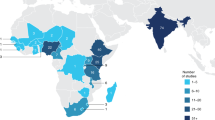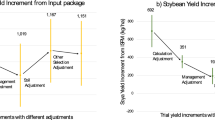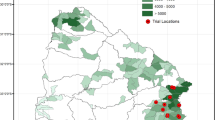Abstract
Sustainably feeding the world’s growing population is a challenge1,2,3, and closing yield gaps (that is, differences between farmers’ yields and what are attainable for a given region)4,5,6 is a vital strategy to address this challenge3,4,7. The magnitude of yield gaps is particularly large in developing countries where smallholder farming dominates the agricultural landscape4,7. Many factors and constraints interact to limit yields3,4,5,6,8,9,10, and progress in problem-solving to bring about changes at the ground level is rare. Here we present an innovative approach for enabling smallholders to achieve yield and economic gains sustainably via the Science and Technology Backyard (STB) platform. STB involves agricultural scientists living in villages among farmers, advancing participatory innovation and technology transfer, and garnering public and private support. We identified multifaceted yield-limiting factors involving agronomic, infrastructural, and socioeconomic conditions. When these limitations and farmers’ concerns were addressed, the farmers adopted recommended management practices, thereby improving production outcomes. In one region in China, the five-year average yield increased from 67.9% of the attainable level to 97.0% among 71 leading farmers, and from 62.8% to 79.6% countywide (93,074 households); this was accompanied by resource and economic benefits.
This is a preview of subscription content, access via your institution
Access options
Subscribe to this journal
Receive 51 print issues and online access
$199.00 per year
only $3.90 per issue
Buy this article
- Purchase on Springer Link
- Instant access to full article PDF
Prices may be subject to local taxes which are calculated during checkout



Similar content being viewed by others
References
Tilman, D., Cassman, K. G., Matson, P. A., Naylor, R. & Polasky, S. Agricultural sustainability and intensive production practices. Nature 418, 671–677 (2002)
Tilman, D., Balzer, C., Hill, J. & Befort, B. L. Global food demand and the sustainable intensification of agriculture. Proc. Natl Acad. Sci. USA 108, 20260–20264 (2011)
Godfray, H. C. J. et al. Food security: the challenge of feeding 9 billion people. Science 327, 812–818 (2010)
Mueller, N. D. et al. Closing yield gaps through nutrient and water management. Nature 490, 254–257 (2012)
Lobell, D. B., Cassman, K. G. & Field, C. B. Crop yield gaps: their importance, magnitudes, and causes. Annu. Rev. Environ. Resour. 34, 179–204 (2009)
van Ittersum, M. K. et al. Yield gap analysis with local to global relevance—a review. Field Crops Res. 143, 4–17 (2013)
Foley, J. A. et al. Solutions for a cultivated planet. Nature 478, 337–342 (2011)
Chen, X. et al. Producing more grain with lower environmental costs. Nature 514, 486–489 (2014)
Fan, S. G., Brzeska, J., Keyzer, M. & Halsema, A. From subsistence to profit: transforming smallholder farm. International Food Policy Research Institute, Washington DC http://www.ifpri.org/ (2013)
Tittonell, P. & Giller, K. E. When yield gaps are poverty traps: The paradigm of ecological intensification in African smallholder agriculture. Field Crops Res. 143, 76–90 (2013)
Denning, G. et al. Input subsidies to improve smallholder maize productivity in Malawi: toward an African green revolution. PLoS Biol. 7, 2–10 (2009)
Ray, D. K., Ramankutty, N., Mueller, N. D., West, P. C. & Foley, J. A. Recent patterns of crop yield growth and stagnation. Nat. Commun. 3, 1293–1299 (2012)
George, T. Why crop yields in developing countries have not kept pace with advances in agronomy. Glob. Food Secur. 3, 49–58 (2014)
West, P. C. et al. Leverage points for improving global food security and the environment. Science 345, 325–328 (2014)
Zhang, X. Y., Pei, D. & Chen, S. Y. Root growth and soil water utilization of winter wheat in the North China Plain. Hydrol. Processes 18, 2275–2287 (2004)
Jia, X. P. et al. Farmer’s adoption of improved nitrogen management strategies in maize production in China: an experimental knowledge training. J. Integr. Agric. 12, 364–373 (2013)
Vereijken, P. A. Methodical way of prototyping integrated and ecological arable farming systems (I/EAFS) in interaction with pilot farms. Eur. J. Agron. 7, 235–250 (1997)
Cash, D. W. et al. Knowledge systems for sustainable development. Proc. Natl Acad. Sci. USA 100, 8086–8091 (2003)
Waddington, H. & White, H. Farmer Field Schools: From Agricultural Extension to Adult Education 17 (International Initiative for Impact Evaluation, 2014)
MacMillan, T. & Benton, T. G. Agriculture: Engage farmers in research. Nature 509, 25–27 (2014)
van den Noort, P. C. Land consolidation in The Netherlands. Land Use Policy 5, 11–13 (1987)
Rosegrant, M. W. & Cline, S. A. Global food security: challenges and policies. Science 302, 1917–1919 (2003)
Swanson, B. E. & Samy, M. M. Developing an extension partnership among public, private, and nongovernmental organizations. J. Int. Agric. Extension Educ. 9, 5–10 (2002)
Fisher, M. Public-private collaboration to advance agronomy. CSA News, Madison https://dl.sciencesocieties.org (2012)
Li, Y. et al. An analysis of China’s fertilizer policies: Impacts on the industry, food security, and the environment. J. Environ. Qual. 42, 972–981 (2013)
National Bureau of Statistics of China. Handan Statistical Yearbook (China Statistics Press, Beijing, 2015)
Zhao, Y., Chen, X. P., Cui, Z. L. & Lobell, D. B. Using satellite remote sensing to understand maize yield gaps in the North China Plain. Field Crops Res. 183, 31–42 (2015)
Niu, L. A., Hao, J. M., Zhang, B. Z. & Niu, X. S. Influences of long-term fertilizer and tillage management on soil fertility of the North China Plain. Pedosphere 21, 813–820 (2011)
Jia, W. Z., Xu, G. H. & Niu, J. G. The Land Productivity Investigation and Quality Evaluation of Quzhou County [in Chinese with English abstract] (China Agriculture Press, Beijing, 2009)
Chen, J. et al. Use of water balance calculation and tritium to examine the dropdown of groundwater table in the piedmont of the North China Plain (NCP). Environ. Geol. 44, 564–571 (2003)
Lu, D. J. et al. Manure limits wheat yield losses due to delayed seeding. Agron. J. 107, 2294–2302 (2015)
Chen, X. P. et al. Integrated soil-crop system management for food security. Proc. Natl Acad. Sci. USA 108, 6399–6404 (2011)
SAS Institute. SAS User’s Guide: Statistics (SAS Institute, 1998)
Zhang, N., Du, X., Jiang, D. L. & Cui, Y. H. Effect of sowing date on growth and yield of summer corn (Zea mays L.). J. Agric. Univ. Hebei [in Chinese with English abstract] 32, 7–11 (2009)
Acknowledgements
We thank P. M. Vitousek, P. A. Matson, P. Christian, T. H. Misselbrook, G. P. Robertson, D. R. Chadwick, I. Ortiz-Monasterio, X.J. Liu and J. D. Toth for their comments/editing assistance. We thank Q. F. Meng, D. J. Lu, P. Yan, X. Q. Jiao and M. L. Guo for joint field experiment and data analysis. Many individuals were involved in the STB Network in Quzhou and elsewhere in China. This work was sponsored by the China 973 Program (Grant 2015CB150405), the Innovative Group Grant of the Natural Science Foundation of China (Grant 31421092), the Special Fund for Agro Scientific Research in the Public Interest (Grant 201203079), and the Program for New Century Excellent Talents in University (Grant 2016QC125).
Author information
Authors and Affiliations
Contributions
F.Z., X.L. and W.Z. designed the research. G.C., H.Z., C.W., Q.L., X.C., Z.C., W.Z., J.S., R.J., G.M. and Y.M. conducted field experiments and ran the STB network. G.C. and W.Z. collected and analysed the data. W.Z., G.C. F.Z. and Z.D. wrote the manuscript.
Corresponding author
Ethics declarations
Competing interests
The authors declare no competing financial interests.
Additional information
Reviewer Information
Nature thanks K. Giller, M. van Ittersum and the other anonymous reviewer(s) for their contribution to the peer review of this work.
Extended data figures and tables
Extended Data Figure 1 Distribution of STBs in China (left) and the location of Quzhou County as well as STB study areas in Quzhou (close-up map at right).
Each dot on the left map indicates an STB group at the county level; the number in the dots refers to the number of STBs in the county. Different colours refer to different cropping systems. The STBs presented in the close-up map at right are for wheat/maize rotation systems only. (Editor’s note: Nature remains neutral with regard to jurisdictional claims in published maps.)
Extended Data Figure 2 Variation in farmers’ standard practices for wheat (n = 150) and maize (n = 145) in Quzhou County based on 2009 survey results.
a, Wheat variety selection. The light shade means farmers used seeds reserved from their own harvest. b, Wheat-sowing date. October 10th was set as 0 because it was the recommended sowing date. c, Wheat-seeding rate. d, N application for wheat. e, Top-dressing date for wheat. April 1st was set as 0 because it was the stem elongation stage. f, Maize variety selection. g, Sowing date of maize. June 10th was set as 0 because it was the recommended sowing date. h, Maize planting density. i, Maize-harvesting date Oct 1st was set as 0 because it was the recommended harvest date of maize. j, N application rate on maize.
Supplementary information
Supplementary Information
This file contains Supplementary Tables 1-5, a Supplementary Discussion and additional references. (PDF 287 kb)
Source data
Rights and permissions
About this article
Cite this article
Zhang, W., Cao, G., Li, X. et al. Closing yield gaps in China by empowering smallholder farmers. Nature 537, 671–674 (2016). https://doi.org/10.1038/nature19368
Received:
Accepted:
Published:
Issue Date:
DOI: https://doi.org/10.1038/nature19368
This article is cited by
-
Global spatially explicit yield gap time trends reveal regions at risk of future crop yield stagnation
Nature Food (2024)
-
Unraveling the prevalence of soil-borne fungal pathogens in the North China Plain: a global analysis approach
European Journal of Plant Pathology (2024)
-
Cost-effective mitigation of nitrogen pollution from global croplands
Nature (2023)
-
Enhanced food system efficiency is the key to China’s 2060 carbon neutrality target
Nature Food (2023)
-
Ammonia mitigation campaign with smallholder farmers
Nature Food (2023)
Comments
By submitting a comment you agree to abide by our Terms and Community Guidelines. If you find something abusive or that does not comply with our terms or guidelines please flag it as inappropriate.



